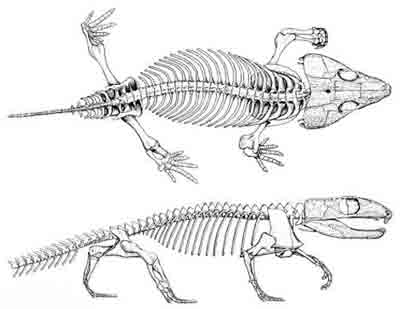Rare Fossil Jaw with Teeth Prehistoric Primitive Reptile Cotylosaur Captorhinus aguti mm 9 x 4 x 3 Permian Paleozoic Collecting Paleontology Museum.
Difficult to find, good quality fossil find with appreciable, very well preserved details of the teeth and maxillary portion. Not restored. Only a piece, as in photos.
Available
at this link 100 g of excellent quality Fossil Sediment from the Lower Permian with many small Paleontological finds, both fragments and intact material of toe bones, jaws, skull plates, teeth, vertebral bodies (intercentra), ends of the bones of arts, etc. Most of the specimens are of prehistoric cotylosaur reptiles such as Captorhinus magnus and Captorhinus aguti.
Captorhinus is an extinct genus of captorhinid anapsids reptiles (Reptilia, Eureptilia, Captorhinida, Captorhinidae, once grouped in the Cotylosauria) that lived during the Permian period. His remains are known from North America, Europe, India and Africa.
Among the different forms of Captorhinus, there are three main species that are the best known: Captorhinus aguti, Captorhinus magnus and Captorhinus laticeps. C. aguti is the typical species of Captorhinus.
The Captorhinus magnus has so far been identified only by the locality of Richards Spur in Oklahoma, a site that has also produced the remains of C. aguti. C. magnus fossils are found mainly in the deepest regions of the fissure fill complex, while in the upper sediments the remains of C. magnus are extremely rare. This suggests the ecological substitution of C. magnus with the small C. acting during the first Permian.

The skeletal elements of Captorhinus magnus possess an almost identical morphology to those elements of Captorhinus aguti, with the sole exception of the difference in size. Captorhinus magnus averaged about twice as much as C. aguti. Another important difference between the two species is that C. magnus teeth are arranged in a single row.
In 1882, Edward Cope described this finding as Ectocynodon aguti. The name was then reviewed several times by different paleontologists while other genres were discovered. Captorhinus comes from the Latin word "captor", which means "one who catches something" and from the Greek word "rhino" which means "of the nose". This is based on the theory that the typically curved Captorhinus curve could have been used to capture prey.
The
Cotilosaurs (Cotylosauria) are an order of fossil reptiles of the sub-class Anapsida (compact skull reptiles, from which today's turtles derived) whose origin dates back to the Carboniferous. They were the first representatives of the reptile class, characterized by squat body, heavy skull and without windows and short limbs: an aspect generally similar to that of primitive amphibians. At the beginning of their history the cotylosaurs were small animals similar to amphibians, but different from them for numerous characters, including the palate, the cranial vault, the inner ear and the vertebrae; the fundamental character, however, is the formation of the amnios, a membrane that envelops the embryo, which remains in this way immersed in the amniotic fluid. This amniotic egg is fundamental for a better adaptation to terrestrial life, and allows the reptile to reproduce itself outside the aquatic environment to which most amphibians were bound.
Appeared in the upper Carboniferous Era of the Paleozoic Era, at the beginning of the Permian period the cotilosaurs developed and prospered, diversifying into many species of various shapes and sizes. Among the main groups to remember the protorotirididi, the most ancient, similar to lizards (including Hylonomus), and the larger, more robust captorinids (including Captorhinus and Labidosaurus). Other more and more specialized forms are the millerettids (provided with temporal windows and once believed to be the ancestors of the diapsides), the mesosaurids (among which Mesosaurus, a crocodile-like animal, returned to a purely aquatic lifestyle) and the great pareiasauri (including Scutosaurus and Pareiasaurus, similar to rhinos). Among the latter were the possible ancestors of the turtles.
During the Permian period, the cotylosaurs gave rise to other more specialized animals, such as the synapsids (for example Dimetrodon) and the diapsids (the small areoscelids), which soon became fierce competitors of the cotylosaurs; the latter, in this way, underwent a drastic reduction at the end of the period, and in the Triassic one only one group survived, that of the procolophones, similar to squat lizards. At the end of the Triassic also these last primitive reptiles disappeared.



